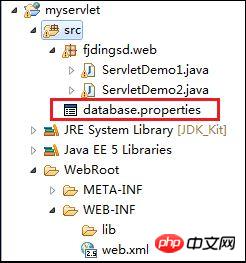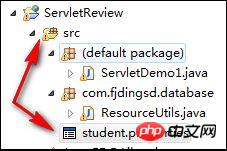Maison >Java >javaDidacticiel >Explication graphique détaillée de la façon d'utiliser ServletContext pour lire des ressources Web en Java
Explication graphique détaillée de la façon d'utiliser ServletContext pour lire des ressources Web en Java
- 黄舟original
- 2017-07-26 15:13:401772parcourir
这篇文章主要介绍了ServletContext读取web资源,小编觉得挺不错的,现在分享给大家,也给大家做个参考。一起跟随小编过来看看吧
ServletContext类中有这么四个方法:
getRealPath(String path)
getResource(String path)
getResourceAsStream(String path)
getResourcePaths(String path)
这四个方法都使用web工程下某个web资源路径的字符串表现形式作为参数,而每个方法返回不同的类型,我们通过这四个方法之一可以获取某个资源,并对其进行读取和修改操作。
假设我们的【myservlet】web工程中有一个数据库的配置文件:database.properties,在这个数据库中已经有了一些参数,而我们在web工程中希望读取这个配置文件中的有关信息:

先来看看ServletContext中的getResourceAsStream()方法,这个方法返回InputStream对象。由于我们的配置文件为properties文件,所以可以用Properties对象来装载这个输入流,代码如下:
public void doGet(HttpServletRequest request, HttpServletResponse response)
throws ServletException, IOException {
ServletContext context = this.getServletContext();
InputStream in = context.getResourceAsStream("/database.properties");
Properties prop = new Properties();
prop.load(in);
String url = prop.getProperty("url");
String username = prop.getProperty("username");
String password = prop.getProperty("password");
System.out.println(url);
System.out.println(username);
System.out.println(password);
}最后在浏览器中访问这个Servlet,那么在MyEclipse的控制台上能看到的数据正好是database.properties中我们配置的信息:

接下来看看ServletContext中的getRealPath()方法,这个方法返回String对象。由于我们的配置文件为properties文件,所以可以用Properties对象来装载这个输入流,代码如下:
ServletContext context = this.getServletContext();
String filePath = context.getRealPath("/database.properties");
FileInputStream fis = new FileInputStream(filePath);
Properties prop = new Properties();
prop.load(fis);
String url = prop.getProperty("url");
String username = prop.getProperty("username");
String password = prop.getProperty("password");
System.out.println(url);
System.out.println(username);
System.out.println(password);最后在浏览器中访问这个Servlet,那么在MyEclipse的控制台上能看到的数据正好是database.properties中我们配置的信息:

使用getRealPath()方法的好处在于这个方法还可以获取文件名,而getResourceAsStream()方法就只能获取文件流了。例如获取文件名:
ServletContext context = this.getServletContext();
String filePath = context.getRealPath("/WEB-INF/web.xml");
System.out.println(filePath);
if(filePath == null) {
System.out.println("所找文件不存在!");
}
String fileName = filePath.substring(filePath.lastIndexOf("\\"));
System.out.println("文件为:"+fileName);接着来看看ServletContext中的getResource()方法,这个方法返回URL对象。而URL对象具有打开到此 URL 的连接并返回一个用于从该连接读入的 InputStream的openStream()方法。由于我们的配置文件为properties文件,所以可以用Properties对象来装载这个输入流,代码如下:
ServletContext context = this.getServletContext();
URL fileUrl = context.getResource("/database.properties");
InputStream in = fileUrl.openStream();
Properties prop = new Properties();
prop.load(in);
String url = prop.getProperty("url");
String username = prop.getProperty("username");
String password = prop.getProperty("password");
System.out.println(url);
System.out.println(username);
System.out.println(password);最后在浏览器中访问这个Servlet,那么在MyEclipse的控制台上能看到的数据正好是database.properties中我们配置的信息:

以上说完了几种通过ServletContext对象来读取web应用下的某个资源文件,只要通过读取的方法,并将资源相对于web工程的路径作为参数传入其中便可。我们上述的例子都是直接在web工程中,或者web工程的某个目录下,而如果我们把某个web资源放置在MyEclipse中的【src】目录中,那么该如何读取呢:

我们说过,这个web应用在发布时,会将【src】目录下的.java文件编译成为.class字节码文件,由服务器自动将这些字节码文件放置在该web应用中的【WEB-INF】下的【classes】目录里,如果没有【classes】目录,服务器会自动帮我们创建,因此,只要是放置在【src】目录中的资源,最后也会被服务器自动放置在【classes】目录中,这样我们可以继续通过ServletContext对象来获取:
ServletContext context = this.getServletContext();
InputStream in = context.getResourceAsStream("/WEB-INF/classes/database.properties");
Properties prop = new Properties();
prop.load(in);
String url = prop.getProperty("url");
String username = prop.getProperty("username");
String password = prop.getProperty("password");
System.out.println(url);
System.out.println(username);
System.out.println(password);
关于web工程下某个web资源在不同位置下的问题:
问题一:我们为什么不能用传统方式,如FileInputStream或者File对象来直接获取web工程中的资源呢?其实也是可以的,但是有个路径的问题,Servlet中方法所需要的路径都是相对于web应用的路径,而传统的FileInputStream等等中方法所需的路径参数都是相对于虚拟机的路径。而又因为我这个web应用是从MyEclipse中的Tomcat里启动的,所以这时候的虚拟机目录其实是Tomcat中的【bin】目录。所以如果想用传统方式读取文件必须每次都将文件放置在Tomcat的【bin】目录下, 这是多么麻烦的事,因此我们开发web工程就应该使用web工程中的方法来读取文件!但是,这却又引出了问题二。。。
问题二:当我们web工程中有别的非Servlet的类时,比如JavaBean,当JavaBean需要连接数据库时,这就是非Servlet对象读取web工程中的资源文件了,不能用ServletContext来读取,问题一种也说过不能用传统方式如FileInputStream来读取,那么该如何读取呢?
答案是:类加载器!由于在【src】目录下的Java程序经过编译成字节码class文件,如果要用到这些类,Java虚拟机需要先将这些字节码文件加载到内存中才可以使用,而这个过程就是由类加载器来完成。因此这就有一个知识点,如果我们将某个web资源放置在【src】目录下,因为这是个web工程,服务器会自动将各个字节码文件重新放置在【classes】目录下, 而这个web资源也会重新被服务器放置在【classes】目录下,那么类加载器能加载【classes】目录下所有的字节码文件,同时,同处在这个目录下的web资源也会被类加载器加载进内存,这时我们就可以使用类加载器读取该web资源了。
例:在【myservlet】的dao包中创建一个Student的JavaBean对象,并在src【目录下】创建一个student的配置文件student.properties,而这个配置文件内容如下图所示:

在Student类中,我们需要通过类加载器来获取输入流来读取这个文件:
public class Student {
public void getStudent() throws IOException {
ClassLoader loader = Student.class.getClassLoader();
InputStream in = loader.getResourceAsStream("student.properties");
Properties prop = new Properties();
prop.load(in);
String studentName = prop.getProperty("name");
String studentAge = prop.getProperty("age");
System.out.println(studentName+":"+studentAge);
}
}另外创建一个Servlet作为可以供浏览器访问的对象,在该Servlet中创建Student的示例来获取配置文件中的内容,这样就达到了从非Servlet对象读取web资源内容并向Servlet对象传递数据:
public class ServletDemo extends HttpServlet {
public void doGet(HttpServletRequest request, HttpServletResponse response)
throws ServletException, IOException {
Student student = new Student();
student.getStudent();
}
}从浏览器中访问该Servlet,可以看到通过类加载器读取的配置文件中的内容:

注意,这种方法只能是web资源放置在【src】目录中才可以使用,如果要读取的web资源是放置在web工程的目录下,使用类加载器也还是无法读取,因为类加载器只能读取类目录下的文件,这时候非Servlet类就无法读取资源文件,只能使用ServletContext来读取了。
方立勋老师说:“类加载器只能加载【classes】目录下的所有文件一次,这样在服务器运行web工程的过程中,如果我们修改【classes】目录下的student.properties配置文件,则由于类加载器不再加载,因此使用类加载器的方式不能读取修改后的内容”
但是我修改后,还是可以使用类加载器的方式读取classes】目录下修改后的student.properties配置文件,难道是因为JDK7的原因吗?
不过不管是什么原因,方立勋老师针对他的问题所采取的解决方案还是值得学习的,他采用先用类加载器获取该配置文件的路径,然后再采用传统方式获取这个文件的输入流。所以在Student中的getStudent()方法代码改为:
public class Student {
public void getStudent() throws IOException {
ClassLoader loader = Student.class.getClassLoader();
URL fileUrl = loader.getResource("student.properties");
String filePath = fileUrl.getPath();
FileInputStream fis = new FileInputStream(filePath);
Properties prop = new Properties();
prop.load(fis);
String studentName = prop.getProperty("name");
String studentAge = prop.getProperty("age");
System.out.println(studentName+":"+studentAge);
}
}这种方式还有一种好处就是,如果要读取的文件过大,而之前通过类加载器将大文件加载进内存就容易导致内存溢出,所以还是采用这种方式比较好。
最后再说明一点,如果是在非Servlet类中采用类加载器获取【classes】目录中的资源,方法参数的路径只需要是相对于【src】目录即可。
补充:使用类加载器加载【classes】目录中的资源,得到的路径取决是哪个虚拟机(或服务器)调用,例如上面的代码getStudent()方法,如果是在非Servlet的类的方法中被调用,那么就是使用JVM虚拟机,那么得到的资源路径并不是Tomcat的应用【webapps】目录的路径。因此如果是要为Servlet中提供资源,那么非Servlet类中获取资源的方法,请一定要使用Servlet来调用,这样才能保证得到的资源路径是在Tomcat服务器下的自己的web应用所在目录中的正确位置。
例如下面的例子,我的MyEclipse工作空间在【E】盘,而Tomcat服务器所在路径为【F】盘:
public class ResourceUtils {
public static void main(String[] args) throws IOException {
getResource();
}
@Test
public static void getResource() throws IOException {
ClassLoader loader = ResourceUtils.class.getClassLoader();
URL url = loader.getResource("student.properties");
String path = url.getPath();
System.out.println(path);
}
}而资源为student.properties配置文件,放置的位置为【src】目录下:

这个是在我的一个web应用中定义的一个非Servlet的普通Java类,这个类无论是用JUnit测试还是使用Main函数,亦或是使用别的非Servlet类来调用getResource方法获取在web应用下【src】目录中的student.properties资源,显示的路径为MyEclipse的工作空间,而不是Tomcat服务器:

而如果是使用Servlet来调用的话,才是真正显示在Tomcat中web应用所在的地方:
public class ServletDemo extends HttpServlet {
public void doGet(HttpServletRequest request, HttpServletResponse response)
throws ServletException, IOException {
ResourceUtils.getResource();
}
}
因此在使用web工程中,如果使用非Servlet类来获取资源,请一定注意这个资源路径问题!!!
Ce qui précède est le contenu détaillé de. pour plus d'informations, suivez d'autres articles connexes sur le site Web de PHP en chinois!

